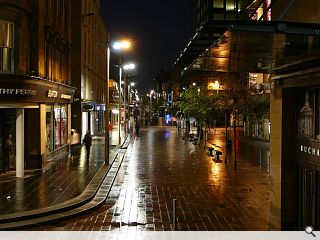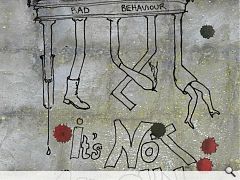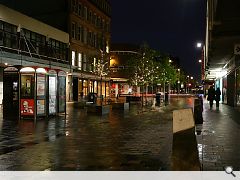Fight Clubs
25 Jul 2011
Glasgow’s Sauchiehall Street, western arm of Glasgow’s primary shopping ‘z’ has, for many, lost its lustre. Citing decline of what ought be a grand boulevard connecting the city centre to the west end is in fact a parade of low rent shops by day and a no go area by night. A situation which has arisen within the lifetimes of many Glaswegians who recall the streets heyday as Glasgow’s premier late night watering hole, and who now sadly reflect upon it merely as a hole.
Sauchiehall Street’s decline has been fuelled by the peculiarly British disease of underage drinking, ned culture and binge drinking and in an effort to identify the issues underlying the problem Urban Realm spoke to the Violence Reduction Unit (VRU), an organisation based just round the corner which observes that: “Violence is an infection that has crept through society to the extent that it is viewed today in much the same way as the common cold – something that is both incurable and inevitable.“In Scotland, violence is a chronic problem. Although overall levels of crime have fallen in the West of Scotland, levels of violent crime, in particular knife crime, have remained relatively constant for the last 40 years.” It is the VRU’s job to ensure that these poor stats don’t remain consistent for a further 40 years but with Strathclyde Police set to jump ship from their own HQ, on nearby Pitt Street - to a Cooper Cromar designed office block in Dalmarnock, policing is set to soon become a little less visible on the street.
Karyn McCluske, co-founder of the VRU, echoed these sentiments, telling Urban Realm: “Physical environments can affect people’s behaviour. For example, if you look at the way a lot of city centre bars are designed these days, they clearly encourage the consumption of alcohol - so called vertical drinking. There will be very few chairs, so you have to drink standing up. The music is loud enough that you won’t be able to hold a conversation, so you’re likely to drink more.
“Several of these kind of bars in a small area, all with the same closing time, in a city where there is a shortage of taxis is a recipe for potential chaos. People talk about the need for café culture in cities in the UK, similar to that on the Continent, but building bars in this way just doesn’t help develop that kind of culture – if you want café culture, you need to build more cafes.”
With that in mind Urban Realm spoke to Jim Hamilton, Graven Images design director, in a bid to ascertain how safety considerations are influencing contemporary interior design. With a number of pubs and club interiors under his belt, notably Edinburgh’s Hotel Missoni and Glasgow’s Corinthian Hamilton believes that these might hold the key to combating the city’s culture of violence.
Hamilton said: “Usually as a designer the key thing is the guest and customer experience but considering things from a safety perspective presents an interesting angle. Sauchiehall St because of the art school always had quite good places, but it just seems to have gone to the dogs completely since the cinema shut down. I couldn’t believe the change, everyone spilling onto the street hammered. I worked in a bar there 25 years ago and there was very seldom any trouble on the street. In those days for a lot of people it was a big journey to get into town and I think nowadays the younger generation with the internet and social networking seem far more confident.”
Looking to what might be done to rectify the situation Hamilton postulated: “Rather than have all the places for young ones congregated in one big area you can split it up a bit because that way you’re getting less of the 18-23 year olds spilling onto the street full of drink. I remember 25 years ago when you had Panama Jacks, Mardi Gras, Warehouse and Maxwell Plums all on the Clydeside, you had a busy mass area there. Then you’ve got Royal Exchange Square and Queen Street where you have Archaos, Cube and Babazaars.” These multiple nodes, Hamilton reflected, served to dissipate groups of drinkers across a far wider chunk of the city, reducing both the size of groups and the likelihood of their interactions on the street.
Hamilton continued: “Looking back over the past 30 years on Sauchiehall Street you had the Cotton Club, I worked in Pythagoras at the and You’ve always had the Variety bar and The Griffin, good student places then you had Cardinal Folly’s and Bar Luxembourg. Why has Sauchiehall Street become this vehicle that it is now because it never was that? There’s no deterrent, most people could probably walk up to Sauchiehall Street get hammered all they want, cause trouble and come back the following week and do the same thing again.”
“For me it’s a cultural thing”, says Hamilton. “When you go abroad you don’t see it. I’m working in Chicago, the birthplace of Al Capone, and you don’t see kids spilling on to the street absolutely hammered with drink. It doesn’t happen. Our culture is to get smashed; you’re not having a good night unless you’re hammered. For me the licensing issue has made Sauchiehall Street a complete dumping ground. A lot of the trouble lies in the fact that they’re filling people up with copious amounts of drink and spilling them onto the street.
“The licensing hours were not just as long then either so you had to be out of town slightly quicker and to be honest in those days most people couldn’t really afford taxis, buses at George Square was the mode of transport most times. Everyone would congregate but what you had then was the police were heavily concentrated and though there was the odd bit of trouble what it did mean was there was going back to the one area to get their transport home. Now when you look at Sauchiehall Street the taxi queues are… Jesus Christ. George Square almost wasn’t a bad thing because it’s a big open space which between the various taxi queues had buses massing all around, so you could actually take 50, 60, 70 people on a bus and get them away from there quickly.”
Hamilton added: “We’ve all been there, we’ve all had a good night being daft and silly but what more can you do to the interior of bars and pubs which mellows people, to make people less confrontational? There have been one or two places that we’ve been looking at recently where the guys have been saying there’s not actually an issue with drugs and there’s not a massive issue with drink. Because they can see it, spot it and put them out. Their problem tends to be testosterone driven guys wanting to fight.” Identifying schemes introduced to mitigate their impact such as stricter enforcement of proof of age schemes and greater collaboration between venues, notably sharing of black lists of barred individuals so that if someone is booted out from one pub then they’re barred from all pubs Hamilton nevertheless mourns the passing of police boxes in their original usage from the city environment.
“The mode of transport at the minute is mainly taxis so you’ve got a queue of 300 people waiting and that lingering time is not a good thing”, Hamilton observes. “I think the taxi wardens are a good idea but there needs to be a way of getting people away from there quickly in buses or trains, say a late train service that ships people away from the area. Some people enjoy that a bag of chips and a kebab to finish the night off but you can see a lot of people desperate to get home, people skip the queue. You can almost look at the reasons which cause angst (apart from the drink), that piss people off and make them want to fight each other.
“The odd thing is if you’ve got a 3 o clock license then chances are people are going to stay until 3 o clock. It’s human nature to stay as late as you can and get your money’s worth. I just wonder if there is a way of dispersing people, spreading it out a bit, so you avoid having these big clusters. I think that’s part of the problem really, you put everyone of the same genre into the same area at the same time then clearly you’re going to have trouble. If you make that full of 30 year olds and thousands of them, you’re going to meet the same issues rearing their heads.
“Things like all night opening so they’re not all coming out at the same time, that’s part of the issue. Most people don’t have the stamina to just keep going all night, people take drugs and whatever else and they get there, but you’ve still got the vast majority that have got a curfew whether it be with their parents or whatever else. The Corinthian Club is a really good example because you’re now getting a lot of young ones going who never went before and they’re occupying the lower section of the building and then you’ve got a slightly older crowd in the middle area. So what you’re getting is young ones who are quite happy to occupy a space with older ones. I just wonder if there’s a model in there.
Maybe what you actually do is create some bigger spaces that in a funny way means you can control a lot of people under the one cover, but maybe break up the age group rather than it all just being full of 18 year olds. “Rather than just have this big club space with a DJ banging sounds out I wonder if the education is in the types of things people do when they socialise. If you think of kids going to Ibiza it isn’t necessarily all about the big Manumission kind of thing, there’s another part of it, the lounging where people relax. Maybe the model is to be geared less toward chucking them in, getting a big bar with as much drink as they can drink and a packed dance floor. Maybe models like the Corinthian which try a few different spaces and don’t just leave people to stand on the one spot all night filling themselves full of drink.”
One architect who is himself not averse to a swally, Will Alsop, informed Urban Realm: “Violence is the outward expression of entrapment. Sadly in our towns and cities today there are many people who feel dissatisfied with their lives at the same time as not knowing what to do to improve it. We are surrounded by rules, regulations, experts, social services, cctv cameras and small-minded politicians enmeshed together in a network that ultimately becomes a prison. To this end it is understandable that people revert to drugs and alcohol which sadly often produce bad behaviour. This violence then breeds new rules, regulations and more cctv cameras. In reality, the society that we have created are the violent ones.
“Architects, designers, environmentalist and planners can help by thinking the unthinkable and engaging in useful naughtiness.”
Bookended by the hollowed out shell of Ryder architecture’s St Andrew House refurbishment for Premier Inn and the burnt out hulk of the former Steak and Cherrie’s, now is perhaps an unfair juncture to pass judgement on this city centre stretch of street. With the recession compounding recent travails with a receding line of retail provision now is perhaps an appropriate window to assess whether a leisure focussed future is one which can deliver the best result for Sauchiehall Street and indeed, Glasgow.
Criminal offences registered in Glasgow City Centre sub division (2010)
- Anti-social Behaviour (Scotland) Act 2004 0
- Breach of the Peace 2797
- Common Assault 2039
- Consumption of alcohol in designated places 2070
- Dangerous driving offences 23
- Drink, Drug driving offences incl. Failure to provide a specimen 102
- Driving Carelessly 104
- Drug – Possession 748
- Drug – Supply 184
- Drunk and Incapable 259
- Housebreaking (Domestic) 55
- Housebreaking (Other) 166
- Mobile phone (whilst driving) offences 999
- Motor Vehicle Crime 361
- Offensive Weapons/Knives 250
- Other Dishonesty 637
- Other Driving Offences 5654
- Other Misc. Crimes 633
- Other Misc. Offences 1673
- Racially Aggravated Conduct/Harassment 198
- Seat belt offences420
- Shoplifting 2409
- Speeding offences 156
- SVC - Attempted Murder8
- SVC - Indecent Assault103
- SVC - Murder (incl. culpable homicide)0
- SVC - Offences related to prostitution45
- SVC - Other Violence/Indecency Crimes56
- SVC - Rape & Attempted Rape10
- SVC - Robbery174
- SVC - Serious Assault190
- Theft 1742
- Vandalism/Fireraising etc.582
- Total recorded crimes: 24847
|
|
Read next: Ruchill Hospital
Read previous: Zed Shed
Back to July 2011
Browse Features Archive
Search
News
For more news from the industry visit our News section.
Features & Reports
For more information from the industry visit our Features & Reports section.





